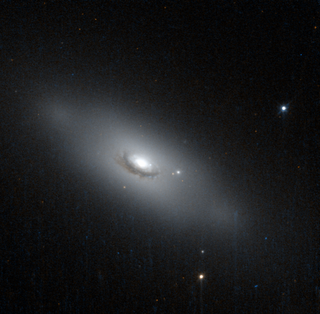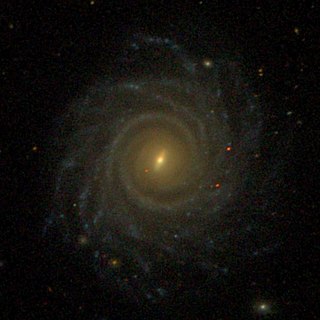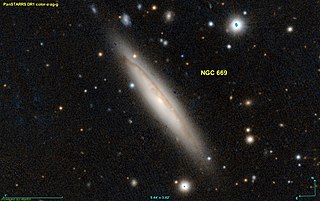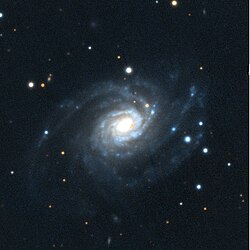
NGC 1260 is a spiral or lenticular galaxy in the constellation Perseus. It was discovered by astronomer Guillaume Bigourdan on 19 October 1884. NGC 1260 is a member of the Perseus Cluster and forms a tight pair with the galaxy PGC 12230. In 2006, it was home to the second brightest supernova in the observable universe, supernova SN 2006gy.

NGC 4207 is a spiral galaxy located about 50 million light-years away in the constellation Virgo. The galaxy was discovered by astronomer Heinrich d'Arrest on March 23, 1865. NGC 4207 is a member of the Virgo Cluster.

NGC 3883 is a large low surface brightness spiral galaxy located about 330 million light-years away in the constellation Leo. NGC 3883 has a prominent bulge but does not host an AGN. The galaxy also has flocculent spiral arms in its disk. It was discovered by astronomer William Herschel on April 13, 1785 and is a member of the Leo Cluster.

NGC 4212 is a flocculent spiral galaxy with LINER activity located about 53 million light-years away in the constellation Coma Berenices. The galaxy was discovered by astronomer William Herschel on April 8, 1784, and was listed in the NGC catalog as NGC 4208. He then observed the same galaxy and listed it as NGC 4212. Astronomer John Louis Emil Dreyer later concluded that NGC 4208 was identical to NGC 4212. NGC 4212 is a member of the Virgo Cluster.

NGC 3981 is an unbarred spiral galaxy located 62 million light-years away in the constellation of Crater. It was discovered on February 7, 1785 by William Herschel.

NGC 708 is an elliptical galaxy located 240 million light-years away in the constellation Andromeda and was discovered by astronomer William Herschel on September 21, 1786. It is classified as a cD galaxy and is the brightest member of Abell 262. NGC 708 is a weak FR I radio galaxy and is also classified as a type 2 Seyfert galaxy.

NGC 668 is a spiral galaxy located 200 million light-years away in the constellation Andromeda. It was discovered by astronomer Édouard Stephan on December 4, 1880 and is a member of Abell 262.

NGC 669 is an edge-on spiral galaxy with an active galactic nucleus located 200 million light-years away in the constellation Triangulum. NGC 669 was discovered by astronomer Édouard Stephan on November 28, 1883 and is a member of Abell 262.

NGC 679 is an elliptical or a lenticular galaxy located 210 million light-years away in the constellation Andromeda. The galaxy was discovered by astronomer William Herschel on September 13, 1784 and is a member of Abell 262.

NGC 703 is a lenticular galaxy located 240 million light-years away in the constellation Andromeda. The galaxy was discovered by astronomer William Herschel on September 21, 1786 and is also a member of Abell 262.

NGC 705 is a lenticular galaxy located 240 million light-years away in the constellation Andromeda. The galaxy was discovered by astronomer William Herschel on September 21, 1786 and is also a member of Abell 262.

NGC 709 is a lenticular galaxy located 150 million light-years away in the constellation Andromeda. It was discovered by the Irish engineer and astronomer Bindon Blood Stoney on October 28, 1850 and is a member of the galaxy cluster Abell 262.

NGC 710 is a spiral galaxy located 260 million light-years away in the constellation Andromeda. It was discovered by the Irish engineer and astronomer Bindon Blood Stoney on October 28, 1850 and is a member of the galaxy cluster Abell 262.

NGC 759 is an elliptical galaxy located 230 million light-years away in the constellation Andromeda. NGC 759 was discovered by astronomer by Heinrich d'Arrest on September 17, 1865. It is a member of Abell 262.

NGC 4076 is a spiral galaxy located 290 million light-years away in the constellation Coma Berenices. The galaxy was discovered by astronomer William Herschel on April 27, 1785 and is a member of the NGC 4065 Group.

NGC 4294 is a barred spiral galaxy with flocculent spiral arms located about 55 million light-years away in the constellation Virgo. The galaxy was discovered by astronomer William Herschel on March 15, 1784 and is a member of the Virgo Cluster.

NGC 7836 is an irregular or spiral galaxy located about 260 million light-years away in the constellation of Andromeda. It was discovered by astronomer Lewis Swift on September 20, 1885.

NGC 4299 is a featureless spiral galaxy located about 55 million light-years away in the constellation Virgo. It was discovered by astronomer William Herschel on March 15, 1784 and is a member of the Virgo Cluster.

NGC 4307 is an edge-on spiral galaxy located about 65 million light-years away in the constellation Virgo. It was discovered by astronomer Christian Peters in 1881 and is a member of the Virgo Cluster. It is also a LINER galaxy.

NGC 4324 is a lenticular galaxy located about 85 million light-years away in the constellation Virgo. It was discovered by astronomer Heinrich d'Arrest on March 4, 1862. NGC 4324 has a stellar mass of 5.62 × 1010M☉, and a baryonic mass of 5.88 × 1010M☉. The galaxy's total mass is around 5.25 × 1011M☉. NGC 4324 is notable for having a ring of star formation surrounding its nucleus. It was considered a member of the Virgo II Groups until 1999, when its distance was recalculated and it was placed in the Virgo W Group.




















